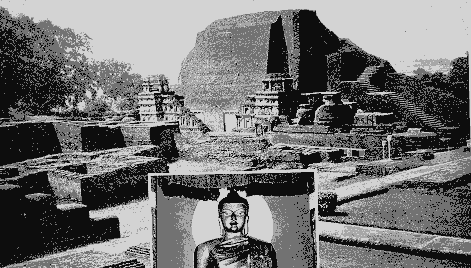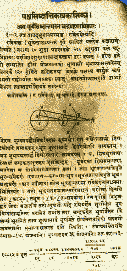Ancient India's Contribution to ASTRONOMY
"In India I found a race of mortals living upon the Earth. but not adhering to it. Inhabiting cities, but not being fixed to them,
possessing everything but possessed by nothing".
- Apollonius Tyanaeus
- Greek Thinker and Traveller 1st Century AD
Astronomy is one area which has fascinated all mankind from the beginnings of history. In India the first references to astronomy are to be found in the Rig Veda which is dated around 2000 B.C. Vedic Aryans in fact deified the Sun, Stars and Comets. Astronomy was then interwoven with astrology and since ancient times Indians have involved the planets (called Grahas) with the determination of human fortunes. The planets Shani, i.e. Saturn and Mangal i.e. Mars were considered inauspicious.
In the working out of horoscopes (called Janmakundali), the position of the Navagrahas, nine planets plus Rahu and Ketu (mythical demons, evil forces) was considered. The Janmakundali was a complex mixture of science and dogma. But the concept was born out of astronomical observations and perception based on astronomical phenomenon. In ancient times personalities like Aryabhatta and Varahamihira were associated with
Indian astronomy.
It would be surprising for us to know today that this science had advanced to such an extent in ancient India that ancient Indian astronomers had recognised that stars are same as the sun, that the sun is center of the universe (solar system) and that the circumference of the earth is 5000 Yojanas. One Yojana being 7.2 kms., the ancient Indian estimates came close to the actual figure.
The Calculation of Eclipses And The Earth's Circumference
In Indian languages, the science of Astronomy is today called Khagola-shastra. The word Khagola perhaps is derived from the famous astronomical observatory at the University of Nalanda which was called Khagola. It was at Khagola that the famous 5th century Indian Astronomer Aryabhatta studied and extended the subject.
Aryabhatta is said to have been born in 476 A.D. at a town called Ashmaka in today's Indian state of Kerala. When he was still a young boy he had been sent to the University of Nalanda to study astronomy. He made significant contributions to the field of astronomy. He also propounded the Heliocentric theory of gravitation, thus predating Copernicus by almost one thousand years.
Aryabhatta's Magnum Opus, the Aryabhattiya was translated into Latin in the 13th century. Through this translation, European mathematicians got to know methods for calculating the areas of triangles, volumes of spheres as well as square and cube root. Aryabhatta's ideas about eclipses and the sun being the source of moonlight may not have caused much of an impression on European astronomers as by then they had come to know of these facts throught the observations of Copernicus and Galileo.
But considering that Aryabhatta discovered these facts 1500 years ago, and 1000 years before Copernicus and Galileo makes him a pioneer in this area too. Aryabhatta's methods of astronomical calculations expounded in his Aryabhatta-siddhanta were reliable for practical purposes of fixing the Panchanga (Hindu calendar). Thus in ancient India, eclipses were also forecast and their true nature was perceived at least by the astronomers.
The lack of a telescope hindered further advancement of ancient Indian astronomy. Though it should be admitted that with their unaided observations with crude instruments, the astronomers in ancient India were able to arrive at near perfect measurement of astronomical movements and predict eclipses.

Indian astronomers also propounded the theory that the earth was a sphere. Aryabhatta was the first one to have propounded this theory in the 5th century. Another Indian astronomer, Brahmagupta estimated in the 7th century that the circumference of the earth was 5000 yojanas. A yojana is around 7.2 kms. Calculating on this basis we see that the estimate of 36,000 kms as the earth's circumference comes quite close to the actual circumference known today.
The Heliocenteric Theory of Gravitation
There is an old Sanskrit Sloka (couplet) which is as follows:
"Sarva Dishanaam, Suryaha, Suryaha, Suryaha."
This couplet means that there are suns
in all directions. This couplet which describes the night sky as full of suns, indicates
that in ancient times Indian astronomers had arrived at
the important discovery that the
stars visible at night are similar to the Sun visible during
day time. In other words, it was
recognised that the sun is also a star, though the nearest
one. This understanding is demonstrated
in another sloka which says that when one sun
sinks below the horizon, a thousand suns
take its place.
 This apart, many Indian astronomers had
formulated ideas about gravity and gravitation.
Brahmagupta, in the 7th century had
said about gravity that "Bodies fall towards the
earth as it is in the nature of the
earth to attract bodies, just as it is in the nature of water
to flow". About a hundred years before
Brahmagupta, another astronomer, Varahamihira
had claimed for the first time perhaps
that there should be a force which might be
keeping bodies stuck to the earth, and also
keeping heavenly bodies in their determined places. Thus the concept of the
existence of some tractive force that governs
the falling of objects to the earth and their
remaining stationary after having once fallen;
as also determining the positions which
heavenly bodies occupy, was recognised.
This apart, many Indian astronomers had
formulated ideas about gravity and gravitation.
Brahmagupta, in the 7th century had
said about gravity that "Bodies fall towards the
earth as it is in the nature of the
earth to attract bodies, just as it is in the nature of water
to flow". About a hundred years before
Brahmagupta, another astronomer, Varahamihira
had claimed for the first time perhaps
that there should be a force which might be
keeping bodies stuck to the earth, and also
keeping heavenly bodies in their determined places. Thus the concept of the
existence of some tractive force that governs
the falling of objects to the earth and their
remaining stationary after having once fallen;
as also determining the positions which
heavenly bodies occupy, was recognised.
It was also recognised that this force is a tractive
force. The Sanskrit term for gravity is
Gurutvakarshan which is an amalgam of Guru-tva-akarshan.
Akarshan means to be
attracted Thus the fact that the character of this
force was of attraction was also
recognised. This apart, it seems that the function
of attracting heavenly bodies was
attributed to the sun.
The term Guru-tva-akarshan can be interpreted to mean,
'to the attracted by the Master".
The sun was recognised by all ancient people to be
the source of light and warmth.
Among the Aryans the sun was deifled. The sun (Surya)
was one of the chief deities in the
Vedas. He was recognised as the source of light (Dinkara),
source of warmth (Bhaskara).
In the Vedas he is also referred to as the source of
all life, the centre of creation and the
centre of the spheres.
The last statement is suggestive of the sun being
recognised as the centre of the universe
(solar system). The idea that the sun was looked
upon as the power that attracts heavenly
bodies is supported by the virile terms like Raghupati
and Aditya used in referring to the
sun. While the male gender is applied to refer to
the sun, the earth (Prithivi, Bhoomi, etc.,)
is generally referred to as a female. The literal
meaning of the term Gurutvakarshan also
supports the recognition of the heliocentric theory,
as the term Guru corresponds with
the male gender, hence it could not have referred to
the earth which was always referred
to as a female.
Many ancient Indian astronomers have also referred to
the concept of heliocentrism.
Aryabhata has suggested it in his treatise
Aryabhattiya. Bhaskaracharya has also made
references to it in his Magnum Opus Siddhanta-Shiromani.
But it has to be conceded that
the heliocentric theory of gravitation was also developed
in ancient times (i.e. around
500 B.C.) by Greek astronomers.
What supports the contention that it could have existed
in India before the Greek
astronomers developed it, is that in Vedic literature
the Sun is referred to as the 'centre
of spheres' alongwith the term Guru-tva-akarshan which
seemingly refers to the sun. The
Vedas are dated around 3000 B.C. to 1000 B.C. Thus the
heliocentric idea could have
existed in a rudimentary form in the days of the
Rig Veda and was refined further by
astronomers of a later age.
lndian Astronomers like Aryabhatta and Varahamihira who
lived between 476 and 587
A.D. made close approaches to the concept of Helicentrism.
In the Surya-Siddhanta, an astronomical text dated
around 400 A.D., the following
appellations have been given to the sun. "He is
denominated the golden wombed
(Hiranyagarbha), the blessed; as being the generator".
He is also referred to as "The
supreme source of light (Jyoti) upon the border of
darkness - he revolves. bringing beings
into being, the creator of creatures". The Surya-Siddhanta
also says that "Bestowing
upon him the scriptures (Vedas) as gifts and establishing
him within the egg as
grandfather of all worlds, he himself then revolves
causing existence". (Quoted from the
Surya-Siddhanta, Translated by Rev. Ebenezer Burgess)
Thus we can see that what ancient Indian astronomers
say comes close to the
heliocentric theory of gravitation, which was a thousand
years later articulated by
Copernicus and Galileo inviting severe reactions from
the clergy in Rome.
Sudheer Birodkar
|